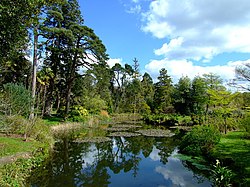Fota Island
| Fota Island Irish: Oileán Fhóta | |
 Fota Gardens | |
|---|---|
| Location | |
| Location: | 51°53’57"N, 8°17’54"W |
| Grid reference: | W795719 |
| Data | |
Fota or Foaty is an island now joined to the mainland in Cork Harbour, on the south coast of County Cork, just north of the larger island of Great Island. The island has two townlands both called Foaty.
On thee island is Ireland's only wildlife park. Here also is the historical Fota House and gardens and a golf course forming part the Fota Island Golf Club and Resort.
Name
The name is of Norse origin. In Irish it appears as Fóite, but this is an adaptation of the original Viking name.
The usual spelling in English is 'Fota', but 'Foaty' is the spelling fixed in the nineteenth century by the Ordnance Survey of Ireland, Fota is now more common.
The origin of the name is uncertain.[1] The second element appears to be the Old Norseey, meaning 'island', so it may be fot ey: 'foot island', from its position at the mouth of the River Lee below the Viking city of Cork.
Fota House and gardens
- Main article: Fota House

Fota House was for many years the home of the Earls of Barrymore, descendants of Philip de Barry who was granted lands in Cork following the Norman invasion of Ireland. The family first resided at Barryscourt Castle in Carrigtwohill, then at Castlelyons. Fota House was originally a hunting lodge but was transformed in the 1820s into a Regency mansion which became the family's main residence. Today it is in state care.

The family developed exotic gardens around the house, taking advantage of the island's wam and sheltered climate. Fota Gardens consist of a structured arboretum, walled garden and terraces, and include rare and exotic shrubs and trees, along with an extensive rose garden.
The development of the arboretum and gardens coincided with the great plant hunting expeditions around the world bringing back specimens from places such as Asia, South America and the Pacific coast of northwest America. Some of these rare plants found their way to Fota within a few years of their discovery.
In 1996 the Irish state was given control of the arboretum and gardens. They are now administered by the Office of Public Works in conjunction with the Irish Heritage Trust.
Fota Island Resort
Fota Island Resort lies within a 780-acre estate (originally the Fota House demesne) comprising woodlands and landscaped areas. Its golf course consisted of three par 71 championship courses. These courses were named Deerpark (Par 71), Belvelly (Par 72) and Barryscourt (Par 73). Golf was first played in Fota Island in 1886.
Fota Wildlife Park

- Main article: Fota Wildlife Park
Opened in July 1983, Fota Wildlife Park has the primary aim of conservation of global wildlife. It is a joint project of the Zoological Society of Ireland and University College, Cork.
Fota Wildlife Park has more than 70 species of exotic wildlife in open surroundings. Animals include ostriches, giraffes, kangaroos, zebras and antelope. Most of the animals who inhabit the island are allowed to roam throughout 50 acres of mature grassland, with the exception of the cheetahs and other predators, which have fenced enclosures. Ring-tailed lemurs, wallabies and other animals freely roam the park.
Many of the animals at Fota are under threat of extinction, and Fota Wildlife Park is involved in breeding programmes for these endangered species, as well as being a breeding source for other zoos around the world. An Asian sanctuary opened between in 2015, and includes enclosures for tigers and other animals. In 2017 the park was the eleventh most popular paid attraction in Ireland, with 455,559 visitors that year.
Outside links
| ("Wikimedia Commons" has material about Fota Island) |
References
- ↑ Ó Corráin, Donnchadh (1997). "Note: Old-Norse place names I: Fodri, Foatey, Fota". Peritia (Brepols) 11: 52. doi:10.1484/J.Peri.3.291. SSN 0332-1592. http://www.brepolsonline.net/doi/abs/10.1484/J.Peri.3.291?journalCode=perit.